Complete Solutions to EXAMPLE of chapter ELECTROMAGNETIC INDUCTION of Class 12 book with complete answers and questions
| Class 12 | PHYSICS |
| Chapter | ELECTROMAGNETIC INDUCTION |
| CP SINGH | EXAMPLE |
| Number Of Questions | 100 |
| Academic Year | 2023-24 |
A long solenoid of radius `3cm` , length `I00cm` carries a current of `4A` . The total number of truns is `300` . Assuming ideal solenoid, find the flux passing through a circular surface having centre on axis of solenoid,
(a) of radius `2cm` and is perprndicular of the axis of solenoid (i) inside and (ii) at the end of solenoid
(b) of radius `4cm` and is perprndicular of the axis of solenoid
(c) of radius greater than `3cm` and angle between normal to area and axis of solenoid is `60^(@)C`10:08View SolutionThe magnetic flux passing prependicular to the plane of the coil directed into the paper is varying according to the relation
`phi=6t^(2)+8t+I0` , where `phi` is in weber and `t` in second.
(a) What is the magnitude of emf induced in the loop when `t=2sec` ?
(b) What is the magnitude and direction of current at `t=2sec` ?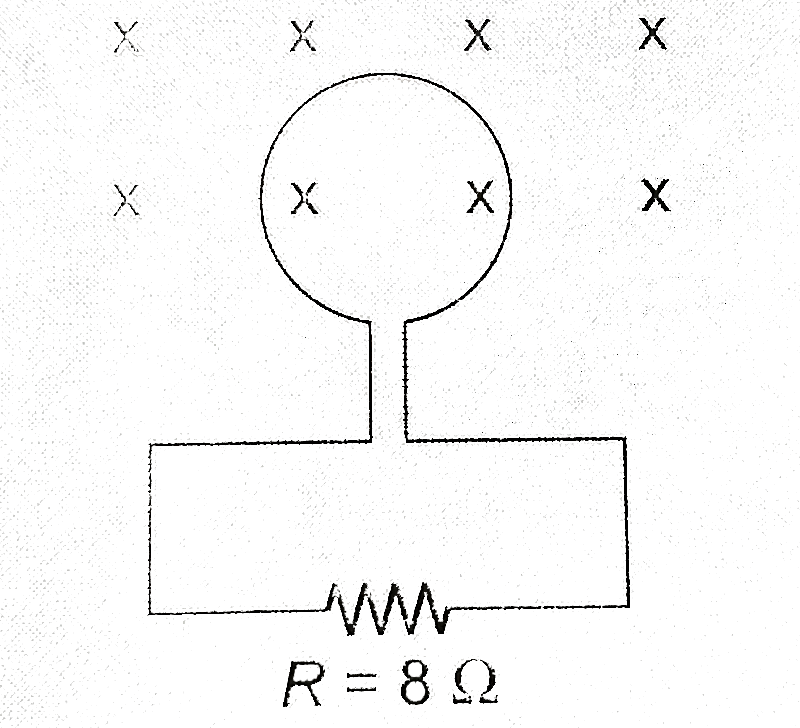 03:10View Solution
03:10View SolutionA wire of length `l` in the from of a circular loop lies in a plane normal to a magnetic firld `B_(0)` . If this wire is converted into a square loop in time `t_(0)` , find the average induced emf.
03:19View SolutionA coil of area `500cm^(2)` and having `1000` turns is held perpendicular to a uniform field of `0.4` gauss. The coil is turned through `180^(@)` in `1//10sec` . Calculate the average indued e.m.f.
05:31View SolutionA closed coil consists of 500 turns has area `4 cm^2` and a resistance of `50 Omega`. The coil is kept with its plane perpendicular to a uniform magnetic field of `0.2 Wb/m^2`. Calculate the amount charge flowing through the coil if it is rotated through `180^@`
02:18View SolutionA coil of area `A` lies in a uniform magnetic field `B` with its plane perpednicular to the field. In this position the normal to the coil makes an angle `0^(@)` with a field. The coil rotates at a uniform rate about its diameter to complete one rotation in time `T` . Find the average induced e.m.f. in the coil during the interval when coil rotates from:
(a) `0^(@)` to `90^(@)`
(b) `90^(@)` to `I80^(@)`
(c) `I80^(@)` to `270^(@)`
(d) `270^(@)` to `360^(@)`04:00View SolutionA conducting loop of area `A` is placed in a magnetic field which varies sinusoidally with time as `B=B_(0)sin`
06:42View SolutionA square loop of edge a having `N` turns is rotated with a uniform angular velocity `omega` about one of its diagonals which is kept fixed in a horizontal position. A uniform magnetic field `B` exists in the vertical direction. Find
(a) the emf induced ion the coil as a function of time `t`
(b) the maximum emf induced
(c) the average emf induced in the loop over a long period (d) the average of the squares of emf induced over a long period
(e) if resistance of loop is `R` , amount of change flow in time `t=0` to `t=2T`
(f) heat produced in time `t =0` to `=4T`
 09:48View Solution
09:48View SolutionA current `i_(0)` is flowing in a long straigh wire situation near a rectangular loop as shown. If the current in the loop as shown . If the current decays iniformly to zero in time `t_(0)` find the emf include in the circuit and determine direction of induced current in the loop .
 07:11View Solution
07:11View SolutionThe magnetic flux passing through a metal ring varies with time `t` according to `phi_(B)=6t^(3)-I8t^(2)` , `t` is in second. The resistance of the ring is `3Omega` . Determine the maximum current induced in the ring during the interval from `t=0` to `t=2sec` .
01:47View SolutionA magnetic flux through a stationary loop with a resistance `R` varies during the time interval `tau` as `phi=at(tau-t)`. Find the amount of the generated in the loop during that time
02:05View SolutionTwo straight conducting rails from a right angle where their end are joined. A conducting bar polaced over the rails starts at vertex at the time `t=0` and moves with a constant velocity `v` to the right as shown in the figure. Calculate
(a) the flux through the triangle (isosceles) by the rails and bar at `t=t_(0)`
the emf around the triangle at that time
(c) in what manner does the emf around the triangle vary with time 05:24View Solution
05:24View SolutionA current `i=alphat` , where `t` is time is flowing in a long wire. A smaller circular loop of radius a has its plane parallel to the wire and is placed at distance `d` from the wire. If resistance per unit length of loop is `lambda` , find the magnitude and direction of the current in the loop.
04:37View SolutionA very small circular loop of area `5xxI0^(-4)m^(2)` , resistance `2Omega` and negligible inductance is initially coplanar and concentric with a much larger fixed circular loop of radius `0.Im` . A constant current of `IA` is passed in the bigger loop and the smaller loop is rotated with angular velocity `omegarad//sec` about a diameter. Calculate (a) the flux limked with the smaller loop, (b) indced emf (c) induced current in the smaller loop, as a function of time.
05:04View SolutionA very small circular loop of radius `r` is initially coplanar and concentric with a much larger circular loop of radius `R(gt gtr)` . A constant current `i` is passed in the larger loop which is kept fixed in space and the small loop is rotated with angular velocity `omega` about a diameter. The resistance of the small loop is `R_(0)` and the inductance is negligible.
(a) Find the current in the small loop as a function of time.
(b) Calculate how much troque must be exerted on the small loop to rotate it.07:06View SolutionThe magnetic field in the cylindrical region shown in figure increases at a constant rate of `20.0mT//sec` . Each side of the square loop abcd and defa has a length of `I.00cm` and a resistance of `4.00Omega` . Find the cuurent (magnitude and sense) in the wire ad if:
(a) the switch `S_(I)` is closed but `S_(2)` is open
(b) `S_(I)` is but `S_(2)` is closed
(c) both `S_(I)` and `S_(2)` are open and
(d) both `S_(I)` and `S_(2)` are closed
 08:04View Solution
08:04View SolutionA uniform magnetic field `B` exists in a direction perpendicular to the palne of a square frame made of copper wire. The wire has a total length of `40cm` . The magnetic field changes with time at a steady rate `(dB//dt)=0.02T//sec` . Find the current induced in the frame. Resistance of wire `=I0Omega`
02:57View SolutionA coil formed by wrapping 50 truns of wire in the shape of square is positioned in a magnetic field so that the normal to plane of the coil makes an angle of `60^(@)` , with the direction of the field. When the magnetic field is increased uniformly from `200muT` to `600muT` in `0.4sec` , an emf of magnitude `I00mV` is induced in the coil. What is the total length of the wire ?
03:59View SolutionA magnetic field induction is changing in magnitude at a constant rate `dB//dt` . A given mass `m` of copper is drawn into a wire into a wire of radius `alpha` and formed into a loop of radius `r` is placed perpendicular to the field. Show that induced current in the loop is given by `i(m)/(4pipdelta)(dB)/(dt)`
`p` : resistivity, `delta` : density of copper.05:52View SolutionA circular coil of radius 2.00 cm has 50 turns. A uniform magnetic field B= 0.200 T exists in the space is a direction parallel to the axis of the loop. The coil is now rotated about a diameter through an angle of `60.0^@`. The operation takes 0.100 s. (a) find the average emf induced in the coil. (b) if the coil is a closed one(with the two ends joined together) and has a resistance of `4.00 Omega`. calculate the net charge crossing a cross- section of the wire of the coil.
03:56View SolutionA closed coil having 100 turns is rotated in a uniform magnetic field `B = 4.0 xx 10^(-4)` T about a diameter which is perpendicular to the field. The angular velocity of rotation is 300 revolutions per minute. The area of the coil is `25 cm^2` and its resistance is `4.0 Omega.` Find (a) the average emf developed in the half a turn form a position where the coil is perpendicular to the magnetic field, (b) the average emf in a full turn and (c) the net charge displaced in part (a).
07:20View SolutionA long solenoid having `200` turns per centimeter carries a current of `1.5 A`. At the center of the solenoid a coil is placed of `100` turns of cross-sectional area `3.14 xx 10^(-4) m^(2)` having its axis parallel to the field produced by the solenoid. When the direction of current in the solenoid is reversed within `0.05 s`, the induced emf in the coil is
03:00View SolutionThe magnetic field B shown in is directed into the plane of the paper. ACDA is a semicircular conducting loop of radius r with the centre at O. The loop is now made ot rotate clockwise with a constant angular velocity `omega` about on axis passing through O and perpendicular to the plane of the paper. The resistance of the loop is R. Obtain an expression for the magnitude of the induced current in the loop. Plot a graph between the induced current i and `omegat`, for two periods of rotation.
 07:15View Solution
07:15View SolutionThe figure shows a square loop wire with sides of length `l=2cm` . A magnetic field position points into the page and its magnitude is given by `B=4t^(2)yT,t` is in second and `y` is in metre. Determine the emf induced around the square at `t=2.5sec` .
 05:03View Solution
05:03View SolutionA Square frame with side a and a straigh conductor carrying a constant current `I` and located in the same plane. The inductance and the resistance of the frame are equal to `L` and `R` respectivaly. The frame was truned through `I80^(@)` about the axis `OO'` separated from the current carrying conductor by a distance `b` . Find the electric charge having flown through the frame.
 12:41View Solution
12:41View SolutionA square loop of edge a has `N` turns and a total resistance `R` . The loop moves with constant velocity `v` through a region of constant magnetic field `B` . The loop enters in magnetic field at `t=0`. Discuss the vartion of (a) Flux passing through the loop (b) the induced emf and (c) the external force acting on the loop a function of position of the loop in the field.
 17:47View Solution
17:47View SolutionA short bar magnet is pulled rapidly through a conductind cooil along its axis with uniform velocity, with its north pole entering the coil first. Sketch vartition of (a) flux, (b) induced current and (c) power dissipated in coil with time.
09:53View SolutionTwo concentric coplanar circular loops made of wire, with resistance per unit length `lambda` , have radii `r_(I)` and `r_(2)(r_(2) gt gtr_(I))` . A potential difference `(alpha+betat)` is applied to the larger loop, where `t` is time. Calculate current in the smaller loop.
04:34View SolutionTwo infinitely long solenoids (shown in cross-section) pass through a circuit as shown in the figure. The magnitude of `vec(B)` inside each is the same and is increasesing at the rate of `I00T//sec` . What is the current in each resistor ?
 12:17View Solution
12:17View SolutionA plane loop is shaped ion the from as shown in the figure with radii `a` and `b` and is placed in a uniform time varying magnetic field `B=B_(0)sinomegat` . Find the amplitude of the current induced in the loop if its resistance per unit length is equal to `lambda` . The inductance of the loop negligible.
 06:14View Solution
06:14View SolutionA `pi` shaped metal frame is located in a uniform magnetic field perpendicular to the plane of the conductor and varying with time at the rate `(dB//dt)=0.I0T//sec` . A conducting connector starts moving with an acceleration `a=I0cm//sec^(2)` along the parallel bars of the frame. The lenght o0f the connector is equal to `l=20cm` . Find the emf induced in the loop `t=2sec` after the beginnig of the motion, if at the moment `t=0` the loop area and the magnetic induction are equal to zero. The inductance of the loop is to be neglected.
06:54View SolutionA metallic meter stick moves with a velocity of `2m//sec` in a diretion perpendicular to its length and perpendicular to a uniform magnetic firld of magnitude `0.2T` . The emf induced between the ends of the stick
01:07View SolutionThe two rails of a railway track, insulataed form each other and from the ground, are connected to a millivoltmeter. What will be the reading of the millivoltmeter when a train travels on the track at a speed of `180km h^(-1)?` The vertical component of earth's magnetic field is` 0.2 xx10^(-4)` and the rails are separted by 1m.
01:58View SolutionThe horizontal component of the earth's magnetic field at a place is `3.0 X 10^(-4) T` and the dip is `53^@`. A metal rod of length 25cm is placed in the north - south direction and is moved at a constant speed of 10cm s^(-1) towards east. Calculate the emf induced in the rod.
02:54View SolutionA right angled triangle abc, made from a metallic wire, moves at a uniform speed v in its plane as shown in . A uniform magnetic field B exists in the perpendicular direction. Find the emf induced (a) in the loop abc, (b) in the segment bc, (c ) in the segment ac and (d) in the segment ab.
 03:59View Solution
03:59View SolutionA copper wire bent in the shape of a semicircle of radius r translates in its plane with a constant velocity v. A uniform magnetic field B exists in the direction perpendicular to the plane of the wire. Find the emf induced between the ends of the wire if (a) the velocity is perpendicular ot the diameter joining free ends, (b) the velocity is parallel to this diameter.
02:33View SolutionA circular copper ring of raidus r translates in its plane with a constant velocity v. A uniform magnetic field b exists in the speace in a direction perpendicular ot the plane o fhte ring. Consider different pairs of diametrically opposite points on the ring. (a) Between which pair of points is the emf? (b) Between which pair of points is the emf minimum? What is the value of this minimum emf?
03:31View SolutionTwo conducting rings of radii `r` and `2r` move in apposite directions with velocities `2 upsilon` and `upsilon` respectively on a conducting surface `S`. There is a uniform magnetic field of magnitude `B` perpendicular to the plane of the rings. The potential difference between the highest points of the two rings is
 03:38View Solution
03:38View SolutionA wire bent as a parabola `y=ax^(2)` is located in a uniformed magnetic field of induaction `B` , the vector `B` being perpendicular to the plane `x-y` . At moment `t=0` a connector starts sliding translationwise from the parabola apex with a constant acceleration `omega` . Find the emf of electromagnetic induction in the loop thus formed as a function of `y`
 05:27View Solution
05:27View SolutionA uniform rod of mas `m` is moving with constant velocity `v_(0)` in a perpendicular uniform magnetic field `B` as shown. The resistance of rod is `r` . The current flowing through rod, `R_(I)` and `R_(2)` will be
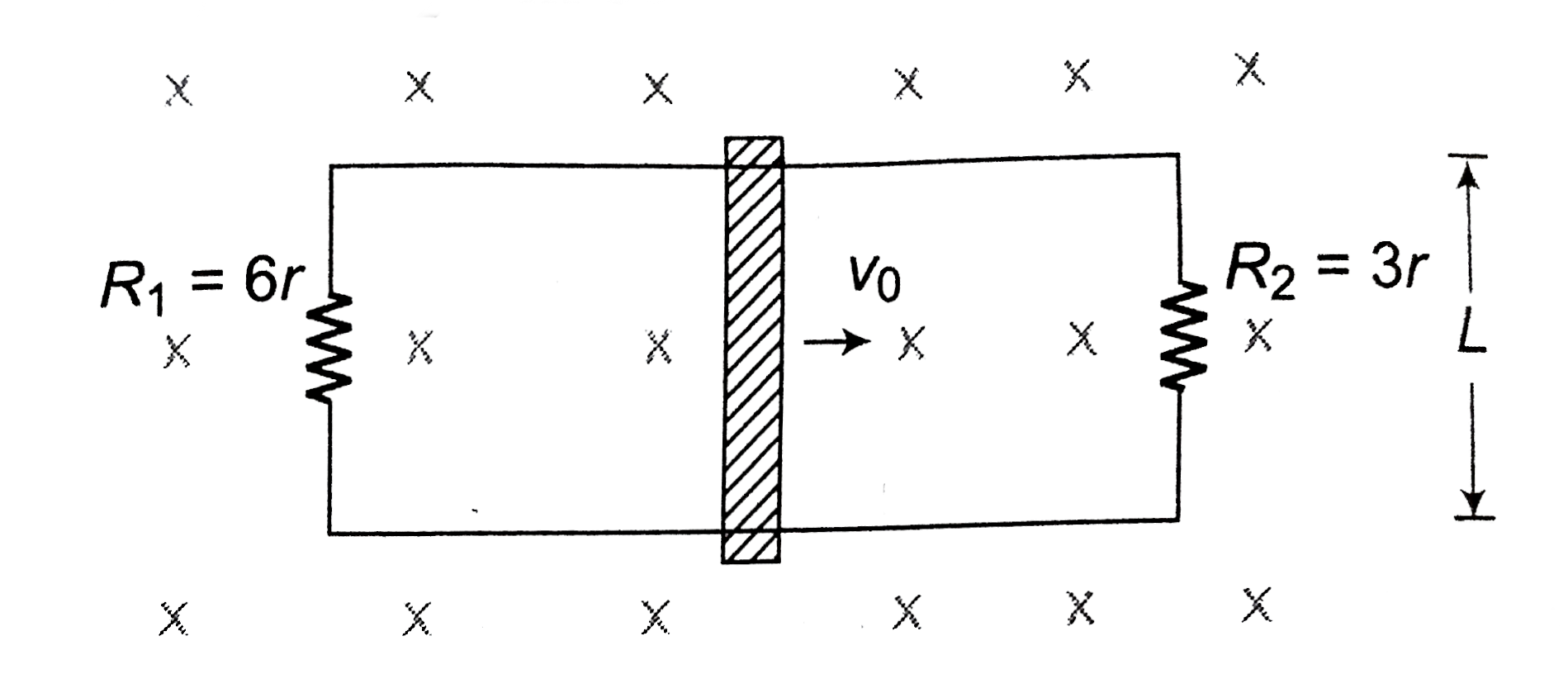 04:48View Solution
04:48View SolutionA vertical ring of radius `r` and resistance on `R` falls vertically. It is in contact with two vertical rails which are joined at the top. The rails are without friction and resistance. There is a horizontal uniform, magnetic field of magnitude `B` perpendicular to the plane of the ring and the rails. When the speed of the ring is `v` , the current in the section `PQ` is
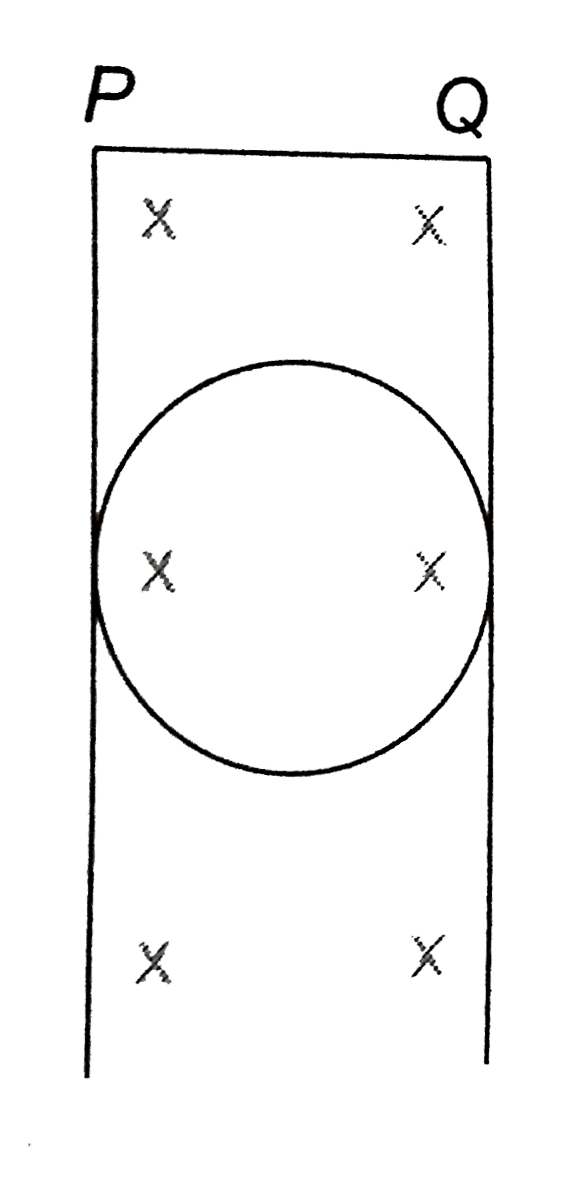 05:39View Solution
05:39View SolutionA square metal wire loop of side 10 cm and resistance 1 ohm is moved with a constant velocity `(v_0)` in a uniform magnetic field of induction `B=2 weber//m^(2)` as shown in the figure. The magnetic field lines are perpendicular to the plane to the loop (directed into the paper). The loop is connected to a network of resistors each of value 3 ohms. The resistances of hte lead wire OS and PQ are negligible. What should be the speed of the loop so as to have a steady current of 1 milliampere in the loop? Given the direction of current in the loop.
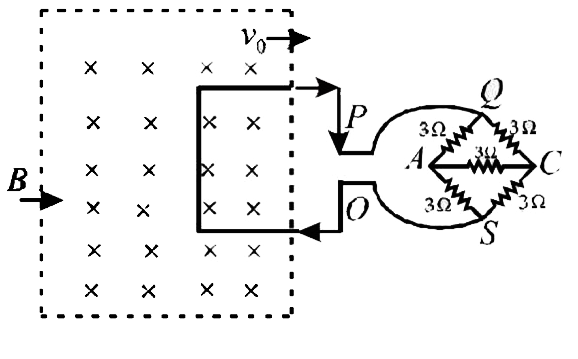 09:45View Solution
09:45View Solutionan electric circuit is component of the three conducting rods `MO` , `ON` and `PQ` , as shown in the figure. The resistence of the rods per unit length is `lambda` . The rod `PQ` slide, as shown in the figure, at a constant velocity `v` , keeping its tilt angle relative to `ON` and `MO` fixed at `45^(@)` . At each instance the circuit is closed. The whole system is embedded in a uniform magnetic field `B` , which is directe dperpendicularly into th epage. Compute the time-dependent induced electric current
 05:58View Solution
05:58View SolutionFigure shown a square loop of side `l` being moved towards right at a constant speed `v` . The front edge enters th emagnetic field `B` at `t=0` . The width of field is `3l` . Sketch induced emf versus time graph.
 12:59View Solution
12:59View SolutionIn the previous problem, fin dthe total heat produced in the loop.
12:59View SolutionShow a rectangular loop MNOP being pullled out of a magnetic field with a uniform velocity v by applying an external force F. The length MN is equal to l and the total resistance of the loop is R. Find(a) the current in the loop,(b) the magnetic force on the loop, (c) the external force F needed to magnetic the velocity, (d) the power delivered by the external force and (e) the thermal power developed in the loop.
 05:02View Solution
05:02View SolutionA rectanguar frame of wire abcd has dimensions `32cm xx 8.0 cm` and a total resistance of `2.0 Omega`. It is pulled out of a magentic field `B = 0.020 T` by applying a force of `3.2 xx10^(-5)` N . It is found that the frame moves with constant speed. Find (a) this constant speed, (b) the emf induced in the loop, (c) the potential difference between the points c and d.
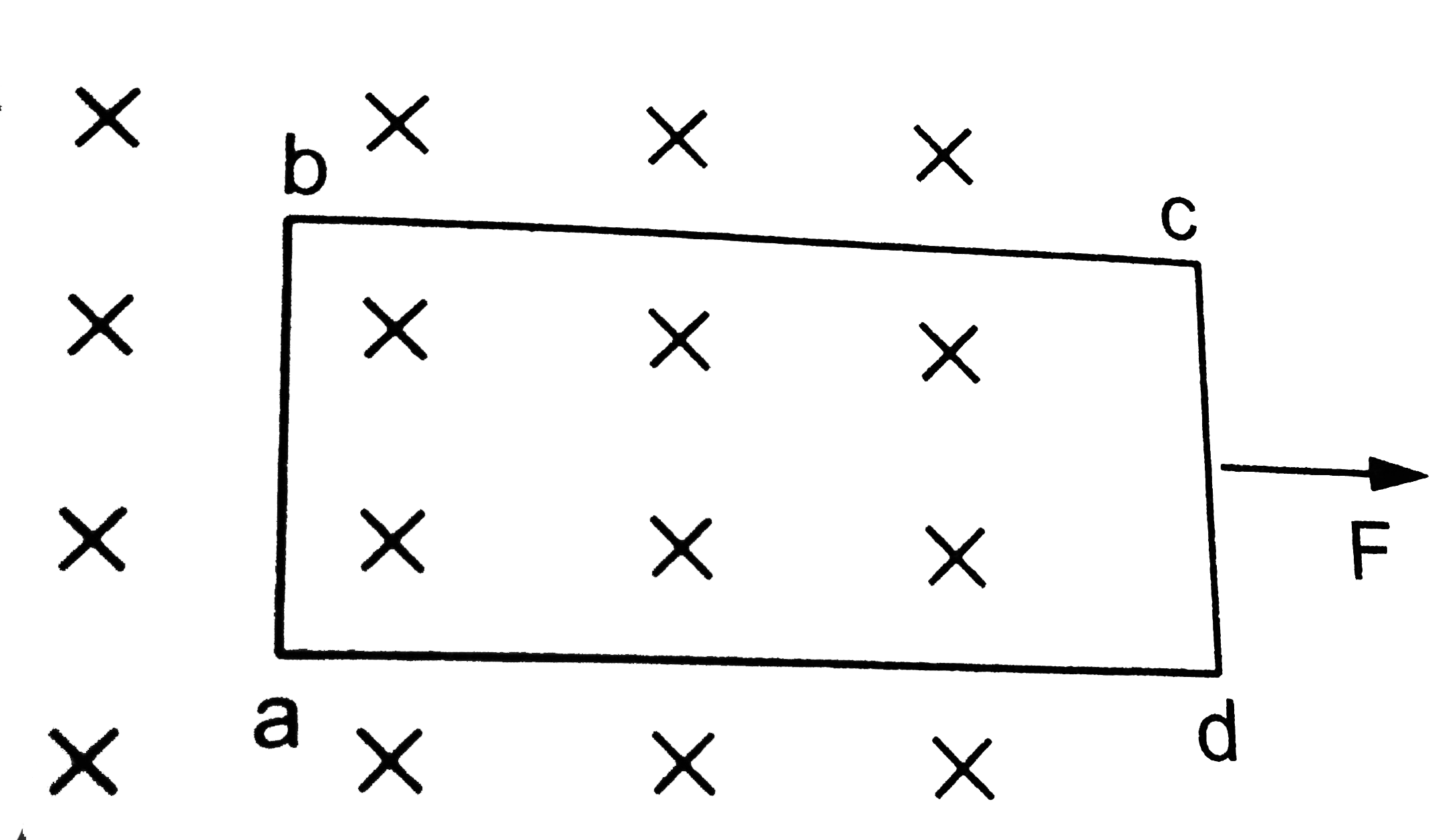 08:13View Solution
08:13View SolutionIn the figure shown the four rods have `lambda` resistance per unit length. The arrangement is kept in a magnetic filed of constant magnitude `B` and directed perpendicular to the plane of the figure and direction inwards. Intially the sides as shown from a square. Now each wire starts moving with constant velocity `v` towards opposite wire. Find as a function of time:
(a) induced emf in the circuit
(b) induced current in the circuit with direction
 09:44View Solution
09:44View SolutionFigure shows a wire `ab` of length `L` and resistance `R` which can slide on a smooth pair of rails. `I_(g)` is current generator which supplies a constant current `i` in the circuit. If the wire `ab` slide at a speed `v` towards right, find the potential difference below `a` and `b`

(b) The current generator `I_(g)` show in the figure sends a constant current `i` through the circiut. The wire `ab` has a length `L` and mass `m` and can slide on the smooth horizontal rails connect to `I_(g)` . The entire system lies in a vertical magnetic field `B` . Find the velocity of the wire as a function of time.

(c) The system containing the rails and the wire of the previous part is kept vertically in a uniform horizontal magnetic field `B` that is perpendicular to the plane of the rails (figure). If is found that the wire stays in equilibrium. If th ewire `ab` is replaced by another wire of double its mass, how long will lit take in falling through a distance equal to its length?
The current generator `I_(g)` shown in figure sends a constant current `i` through the circuit. The wire `cd` is fixed and wire `ab` is made to slide on the smooth, thick rails with a constant velocity `v` toward right. Each of these wires has resistance `r` . Find the current through the wire `cd` .
 11:04View Solution
11:04View SolutionA pair of parallel horizontal conducting rails of negligible resistance shorted at one end is fixed on a table. The distance between the rails is L. A conducting massless rod of resistance R can slide on the rails frictionlessly. The rod is tied to a massless string which passes over a pulley fixed to the edge of the table, A mass m, tied to the other end of the string hanges vertically. A constant magnetic field B exists perpendicular to the table. If the system is released from rest, calculate.
(i) the terminal velocity achieved by the rod, and
the acceleration of the mass at the instant when the velocity of the rod is half the terminal velocity. 08:22View Solution
08:22View SolutionA conducting wire ab of length l, resistance r and mass m starts sliding at t = 0 down a smooth, vertical, thick pair of connected rails as shown in . A uniform magnetic field B exists in the space in a diraction perpendicular to the plane of the rails. (a) Write the induced emf in the loop at an instant t when the speed of the wire is v. (b) what would be the magnitude and direction of the induced current in the wire? (c) Find the downward acceleration of the wire at this instant. (d) After sufficient time, the wire starts moving with a constant velocity. Find this velocity `v_m. (e) Find the velocity of the wire as a function of time. (f) Find the displacement of the wire as a functong of time. (g) Show that the rate of heat developed inte wire is equal to the rate at which the gravitational potential energy is decreased after steady state is reached.
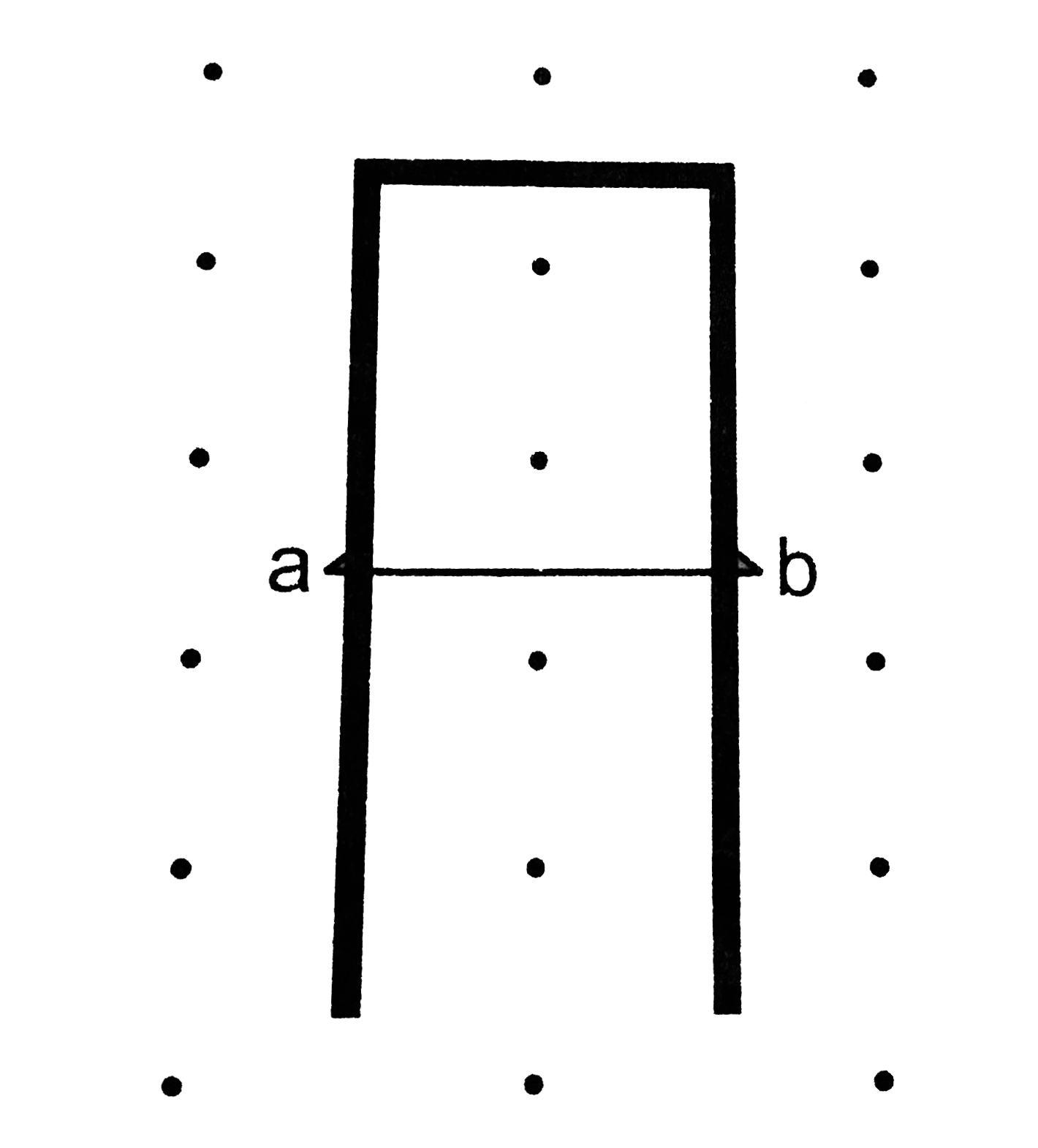 20:52View Solution
20:52View SolutionA metal bar with length `L` , mass `m` and resistance `R` is polaced on frictionless metal rails that are inclined at an angle `phi` above the horizontal. The rails have negiligible resistance. There is a uniform magnetic field of nagnitude `B` direction download in the figure. The bar is released from rest and slide down the rails.
(a) Is the direction of the current induced in the bar from `a` and `b` or `b` to `a` ?
(b) What is the terminal speed of the bar ?
What is the induced current in the bar when the terminal speed has been reached ?
(d) After the terminal speed has been reached, at what rate is electrical energy being converted to thermal energy in the resistance of the bar ?
(e) After the terminal speed has been reached, at what rate is work being done on the bar by gravity? Compare your answer to that in part (d).
 11:02View Solution
11:02View SolutionTwo metal bars are fixed vertically and are connected on the top by a capacitor `C`. A sliding conductor of length land mass m slides with its ends in contact with the bars. The arrangement is placed in a uniform horizontal magnetic field directed normal to the plane of the figure. The conductor is released from rest. Find the displacement `x(t)` of the conductor as a function of time t.
 02:41View Solution
02:41View SolutionTwo parallel vertical metallic rails `AB` and `CD` are separated by `1m`. They are connected at the two ends by resistances `R_1` and `R_2` as shown in the figure. A horizontal metallic bar `l` of mass `0.2 kg` slides without friction, vertically down the rails under the action of gravity. There is a uniform horizontal magnetic field of `0.6 T` perpendicular to the plane of the rails. It is observed that when the terminal velocity is attained, the powers dissipated in `R_1` and `R_2` are `0.76W` and `1.2W` respectively `(g=9.8m//s^2)`
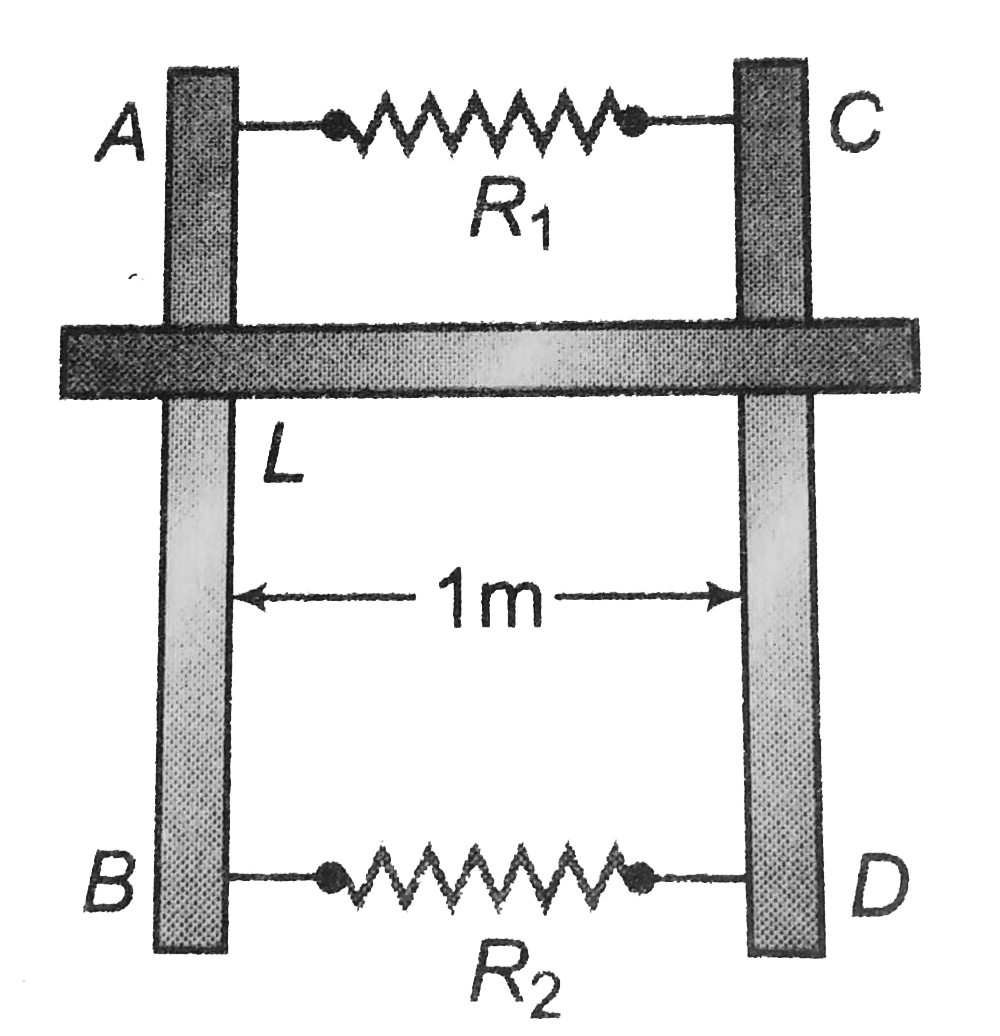
The terminal velocity fo the bar L will be07:20View Solutionshows a straight, long wire carrying a current I and a rod of length l coplanar with the wire and perpendicular to it. The rod moves with a constant velocity v in a direction parallel to the wire. The distance of the wire from the centre of the rod is x. Find the motional emf induced in the rod.
 04:24View Solution
04:24View SolutionThe magnetic field inn a region is given by `vec B = veck (B_0)/(L) y` where L is a fixed length. A conducting rod of length L lies along the Y - axis between the origin and the point (0,L, 0). If the rod moves with a velocity `v= v_0` , find the emf induced between the ends of the rod.
03:43View Solution(a) A metal rod of length `L` rotates about an end with a uniform angular velocity `omega` . A uniform magnetic field `B` exists in the direction of the axis of rotation. Calculate the emf induced between the ends of the rod. Neglect the centripetal force acting on the free electrons as they move in circular paths.
(b) A rod of length `L` rotates with a small but uniform angular velocity `omega` about its perpendicular bisector. A uniform magnetic field `B` exists parallel to the axis of rotation. Find the potential difference (i) between the centre of rod and one end and (ii) between the two ends of the rod.05:37View SolutionFigure shows a conducting circular loop of radius a placed in a uniform, perpendicular magnetic field `B.A` thick metal rod `OA` is pivoted at the centre `O` . The other end of the rod toucher the loop are connected by a wire `OC` of resistance `R.A` force is applied at the middle point of the rod `OA` perpendicularly, so that the rod rotates clockwise at a uniform angular velocity `omega` . Find the force.
(b) Consider the situation shown in the figure of the previous problem. Suppose the wire connecting `O` and `C` has zero resistance but the circular loop has a resistance `R` uniformly distributed along its lenght. The rod `OA` is made to rotate with a uniform angular speed `omega` as shown in the figure. Find the current in the rod when `angleAOC=90^(@)` .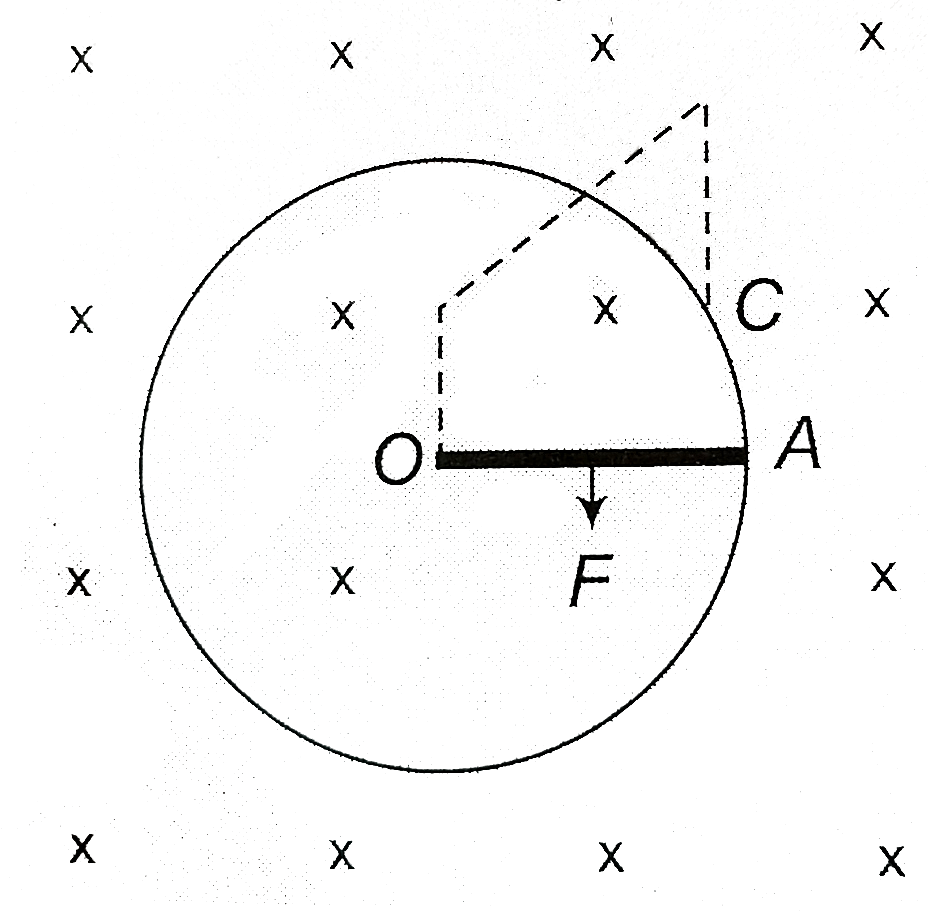 10:37View Solution
10:37View SolutionA vertical copper disc of diameter `20cm` makes `10` revolution per second about a horizontal axis passing through its centre. A uniforjm magnetic field `10^(-2)T` acts perpendicular to the plane of the disc. Calculate the potential defference between its centre and rim in volts.
04:36View SolutionThe magnetic field at all points within the cyllindrical region whose cross section is indicated in the accompanying Figure starts increasing at a constant rate `alpha`. `T//s`. find the magnitud of electric field as a function of `r`, the distance from the geometric centre of the region.
 03:02View Solution
03:02View SolutionThe current in an ideal, long solenoid is varies at a uniform rate of `0.01 As^(-1)`. The solenoid has 2000 turns/m and its radius 6.0 cm. (a) Consider a circle of radius 1.0 cm inside the solenoid with its axis coinciding with the axis of the solenoid. write the change in the magnetic flux through this circle in 2.0 seconds. (b) find the electric field induced at a point on the circumference of hte circle. (c) find the electric field induced at a piont outside the solenoid at a distance 8.0cm from its axis.
09:07View SolutionFor the situation described in figure, the magnetic field changes with time according to
`B=(2.00t^3-4.00t^2+0.8)t` and `r_2=2R=5.0cm`
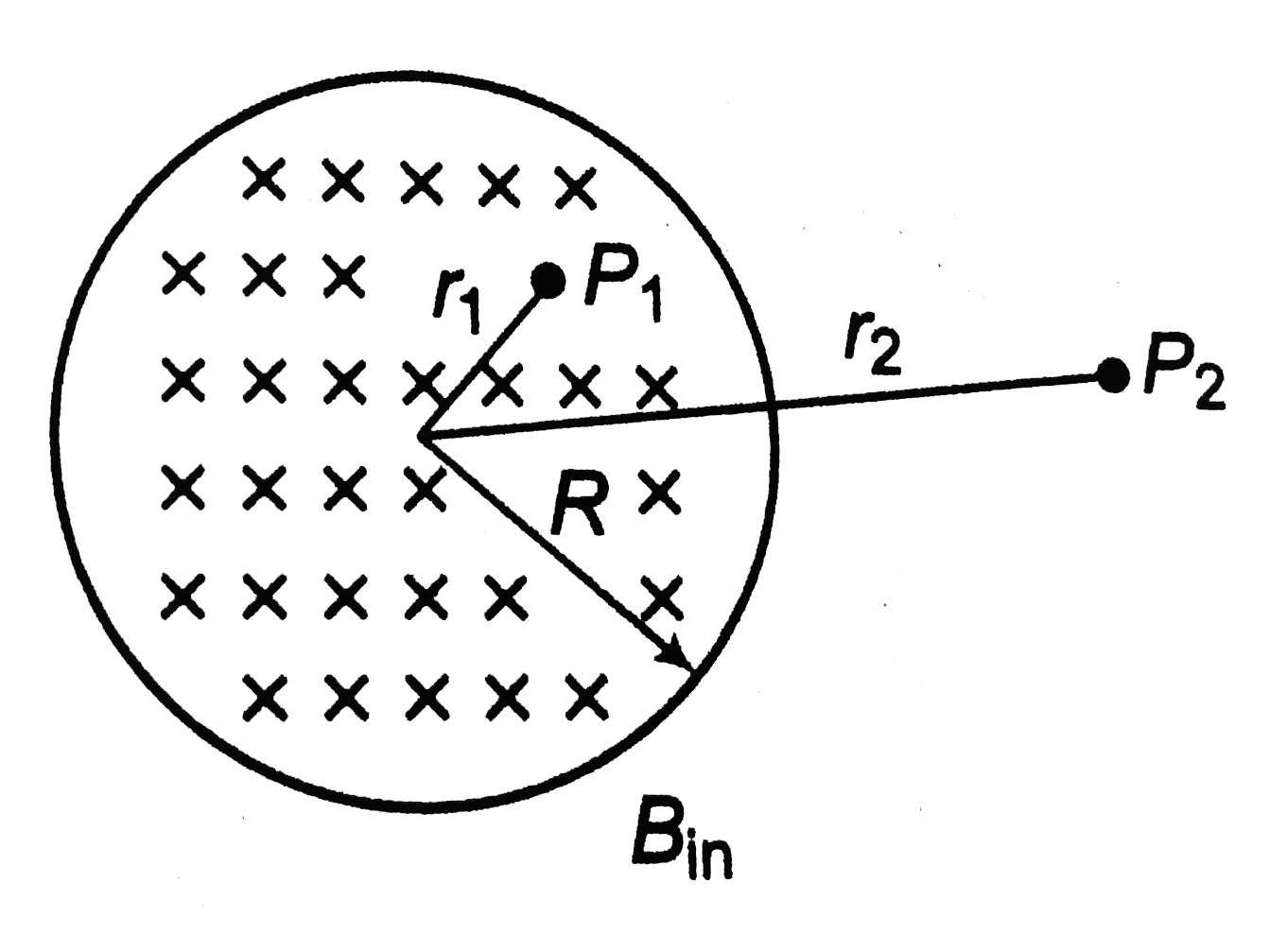
(a) Calculate the force on an electron located at `P_2` at `t = 2.00 s`
(b) What are the magnitude and direction of the electric field at `P_1` when `t = 3.00 s` and `r_1= 0.02 m`.03:14View SolutionA thin non conducting ring of mass `m`, radius a carrying a charge `q` can rotate freely about its own axis which is vertical. At the initial moment, the ring was at rest in horizontal position and no magnetic field was present. At instant `t=0`, a uniform magnetic field is switched on which is vertically downward and increases with time according to the law `B=B_0t`. Neglecting magnetism induced due to rotational motion of ring.
Angular acceleration of ring is06:49View Solution(a) When the current in a coil changes from `8A` to `2A` in `3xx10^(-2)s` , the emf induced in the coil is `2V` . The self-induced of coil in `mH`
(b) A `12V` battery conneted to a `6Omega` . `10H` coil through a switch drives a constant current in the circuit. The switch is suddenly opened. Assuming that it took 1msec to open the switch, calculate the average emf induced across the coil.
(c) The equivalent inductance of two inductored in series. What is the value of inductances of the individual inductors?
(d) If `i=5A` and decreasing at a rate of `10^(3)` (A/sec), find `V_(B)-B_(A)` .
 07:39View Solution
07:39View SolutionCalculate the self-inductance of a coil of `100` turns, if a current of `2A` gives rise to magnetic flux of `50muWb` through the coil. Also calculate the magentic energy stored in the medium surrounding the coil for the above value of current.
01:59View SolutionA `50cm` long solenoid having `500` turns and radius `2cm` is wound on an iron core of relative permeability `800` . What will be the average emf induced in the solenoid if the current in it changes from `0` to `2A` in `0.05` sec?
03:02View SolutionCalculate the time constant `tau` of a straight solenoid of length `l` having a single layer winding of copper wire whose total mass is equal to `m` . The cross-sectional dimater of the solenoid is assumed to be considerably less than its length. Given desity of copper `p_(0)` and resistivility `p` .
04:14View SolutionA supereconducting round ring of radius a and inductance `L` was located in a uniform in a uniform magnetic field of induction `B` . The ring plane was parallel to the vector `B` and the current in the ring was equal to zero, then the ring was turned through `90^(@)` so that its plane became perpendicular to the field. Find
(a) the current induced in the ring after the turn
(b) the work performed during the turn.04:02View SolutionAn inductor coil stores 32 J of magnetic field energy and dissiopates energy as heat at the rate of 320 W when a current of 4 A is passed through it. Find the time constant of the circuit when this coil is joined across on ideal battery.
02:36View SolutionTwo different coils have self-inductances `L_(1)=8mH` and `L_(2)=2mH` At a certain instance the current in thw two coils is increasing at the same constant rate and the power supplied to the coils is the same. Find the ratio of (a) induced voltage (b) current (c) energy stored i the two coils at that instant.
03:09View SolutionA uniformly wound solenoid coil of self inductance `1.8xx10^(-4)H` and resistance `6Omega` is broken up into two identical coils. These identical coils are then connected in parallel across a `12V` battery of negligible resistance. The time constant and steady state current will be
07:39View SolutionThe current in a coil of self-inductance `4H` is given by `i=4sint^(2)` . Find the amount of energy spent during the period when the current changes from `0` to `4A` .
02:30View SolutionThe current in an inductor is given by `i=alpha+betat` , where `t` is time. The self-induced emf in it is `V` . Find
(a) the self-inductance
(b) the energy stored in the inductor and the power supplied to it at time `t=t_(0)`02:07View SolutionA long wire carrying current `i_(0)` is planced near a small cube of edge a at distance `d(d gt gta)` . Find the magnetic energy stored in the loop.
02:28View SolutionConsider a small cube of volume `1 mm ^3` at the centre of a circular loop of radius 10 cm carrying a current of 4 A. Find the magnetic energy stored inside the cube.
02:49View SolutionA long wire carries a current of uniform density. Let `i` be the total current carried by the wire. Show that the magnetic energy per unit length stored within the wire equals `(mu_(0)t^(2))/(16pi)` . Note that it does not depend on the wire diameter.
06:02View SolutionA small circular loop of radius a is placed inside a large square loop of edge `L(gt gta)` . The loops are coplanar and concentric. Find mutual inductance.
03:43View SolutionThe coefficient of mutual inductance
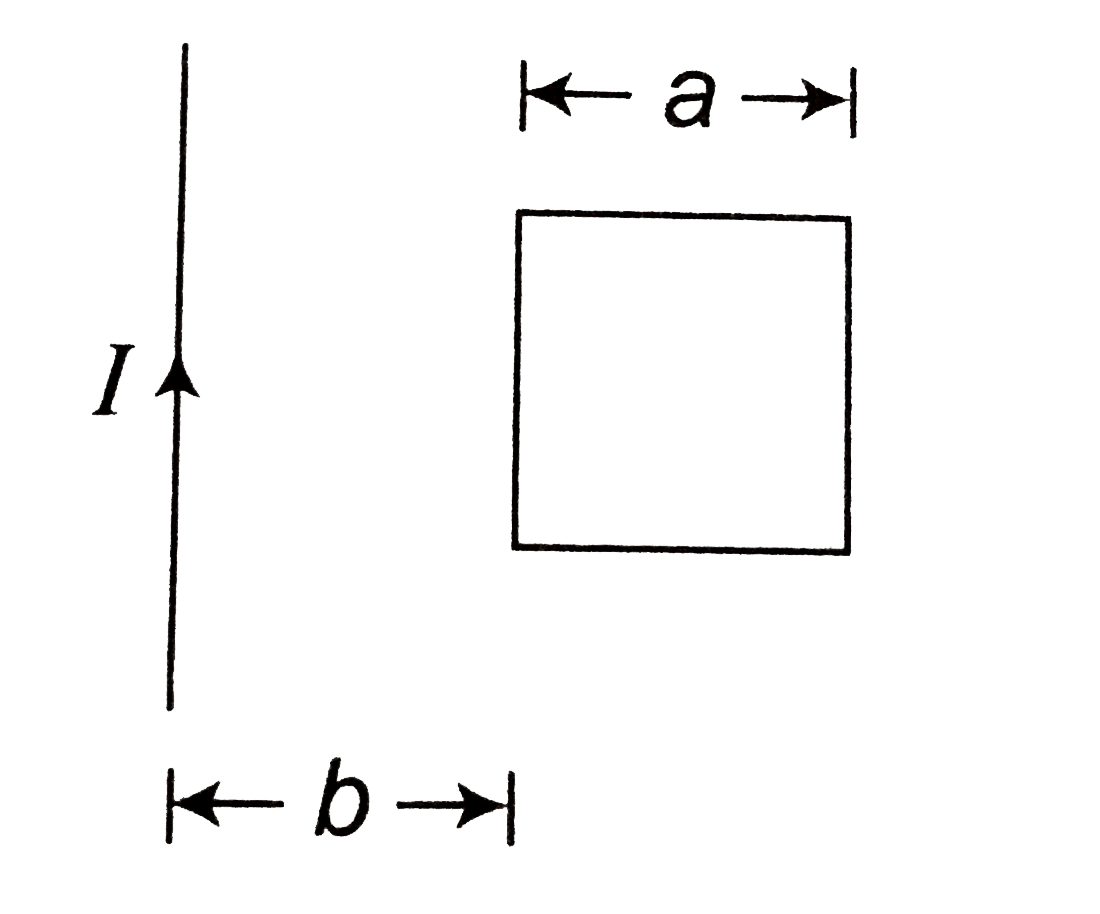 04:58View Solution
04:58View SolutionAs shown in the figure, a long wire is placed near a triangular coil. Calculate the mutual induectance of the combination.
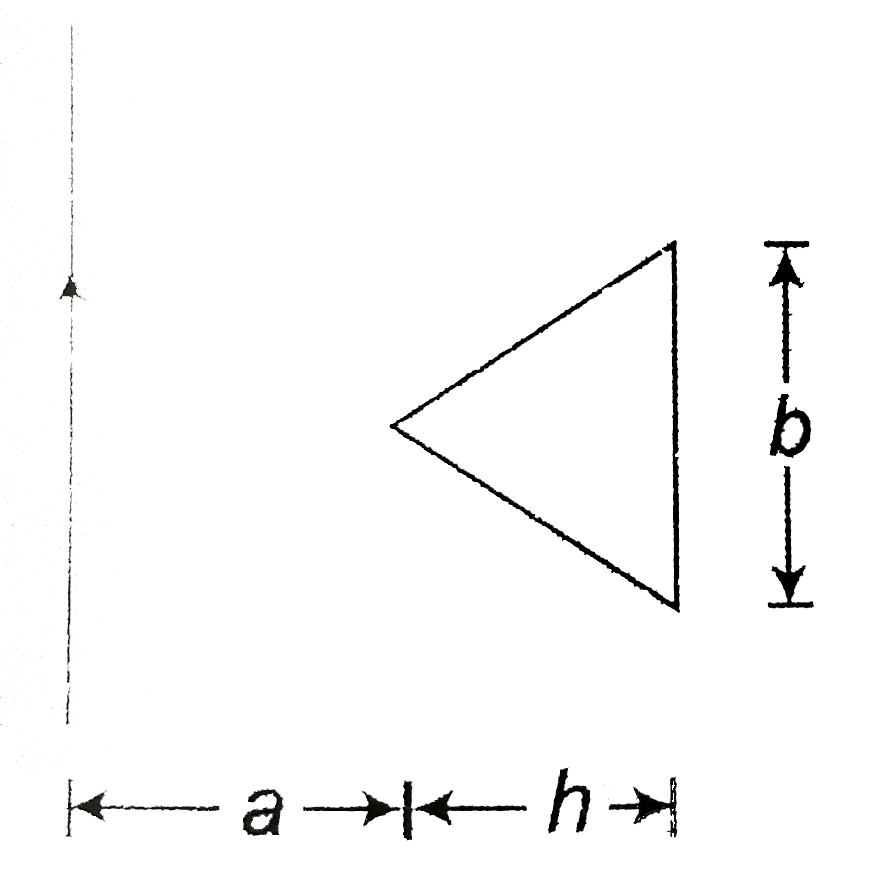 05:36View Solution
05:36View SolutionCalculate the mutual inductance between two coils when a current of `4 A` changes to `12 A` in `0.5 s` in primary and induces an emf of `50 mV` in the secondary. Also, calculate the induced emf in the secondary if current in the primary changes from `3 A` to `9 A` is `0.02 s`.
01:32View SolutionA coil has 600 turns which produces `5 xx 10^-3 Wb//turn` of flux when `3 A` current flows in the wire. This produced `6 xx 10^-3` Wb/turn in 1000 turns secondary coil. When the opened, the current drops to zero in `0.2 s` in primary. Find
(a) mutual inductance,
(b) the induced emf in the secondary,
(c) the self-inductance of the primary coil.01:59View SolutionA circular coil `P` of `100` turns and radius `2cm` is placed coaxially at the centre of another circular coil `Q` of `100` turns and radius `20cm` . Calculate (a) the mutual inductance of the coils
(b) the induced emf in coil `P` when the current in the coil `Q` decreases from `5A` to `3A` in `0.04` sec (Take `pi^(2)=10)`04:38View SolutionFind the steady-state value of current in the circuits.
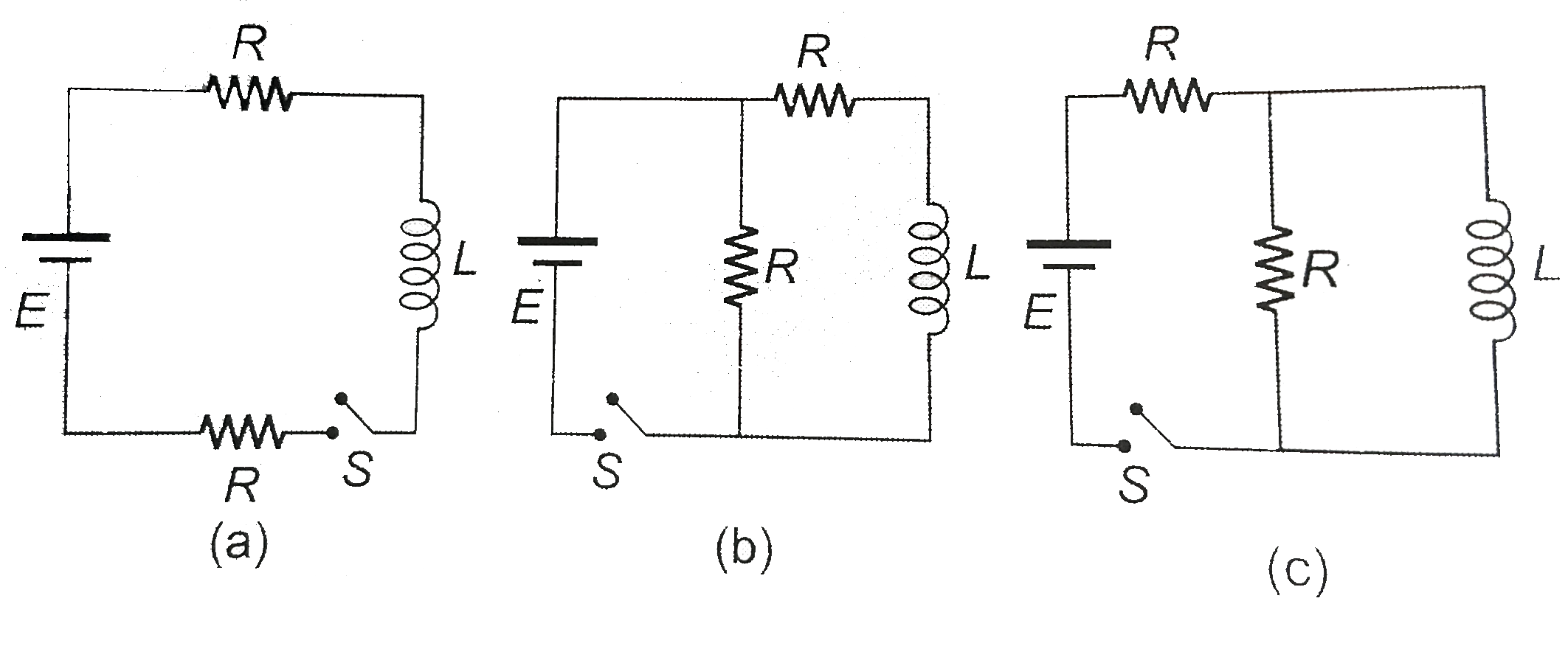 02:31View Solution
02:31View SolutionFind current in `R` , `L` and `2L` in steady state.
 03:22View Solution
03:22View SolutionConsider the circuit shown in the figure. If `E=20V` , `R_(1)=4Omega` , `R_(2)=12Omega` and `L=5H` . Find current `i` , `i_(1)` , `i_(2)` , P.d. across `R_(2)` and `L`
(a) just after closing the switch `(t=0)`
(b) after a long time `(t=oo)`
 05:47View Solution
05:47View SolutionFind current through the battery
(a) just after the switch is closed
(b) long after the switch has been closed
 03:41View Solution
03:41View SolutionA solenoid of resistance `50Omega` and inductance `80H` is connected to a `200V` battery. How long will it take for the current to reach `50%` of its final equilibrium value? Calculate the maximum energy stored.
04:12View SolutionA coil of resistance `20Omega` and inductance `0.5H` is switched to `DC200V` supply. Calculate the rate of increase of current
a. at the instant of closing the switch and
b. after one time constant.
c. Find the steady state current in the circuit.03:07View SolutionA solenoid having inductance 4.0 H and resistance `10 Omega` is connected to a 4.0 V battery at t = 0. Find (a) the time constant, (b) the time elapsed before the current reached 0.63 of its steady state value, (c ) the power delivered by the battery at this instant and (d) the power dissipated in Joule heating at this instant.
06:01View SolutionAt `t=0` , switch `S` is closed, calculate
(a) initial rate of increase of current i.e. `(di)/(dt)` at `t=0`
(b) `(di)/(dt)` at time when current in the circiut is `1A`
(c) current at `t=0.5sec`
(d) rate at which energy of magnetic field is incresing, rate of heat produced in resistance and rate at which energy is supplied by battery when `i=1A`
(e) energy stored in inductor in steady state
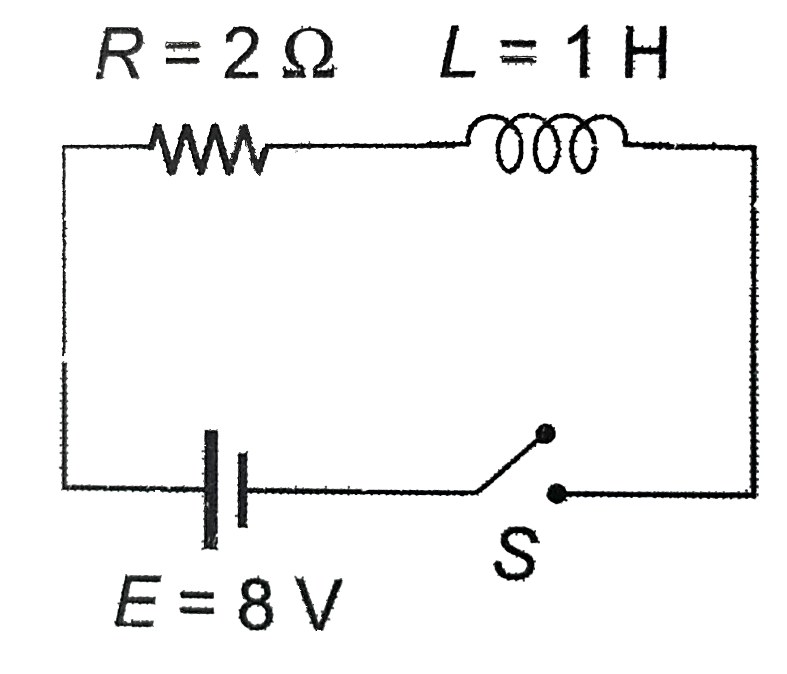 07:26View Solution
07:26View SolutionA coil having an inductance `L` and a resistance `R` is connected to a battery of emf `E` . Find the time taken for the magnetic energy stored in the circuit to change from one fourth of the steady-state value.
05:50View SolutionAt `t=0` , switch `S` closed. Find the ratio of the rate at which magnetic energy stored in the coil to the rate at which energy is supplied by the battery at time `t=tau=L//R` .
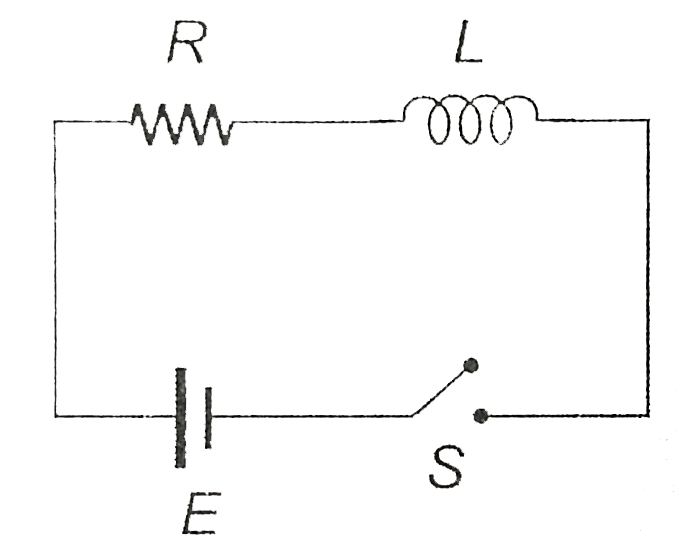 04:39View Solution
04:39View SolutionThe switch is closed for a long time and then opned at time `t=0` . Find the initial voltage across `L` after `t=o` , which end is at higher potential `a` or `b` ?
 05:29View Solution
05:29View SolutionThe switch `S` is closed at time `t=0` . Find the current through the inductor as a function of time `t`
(a)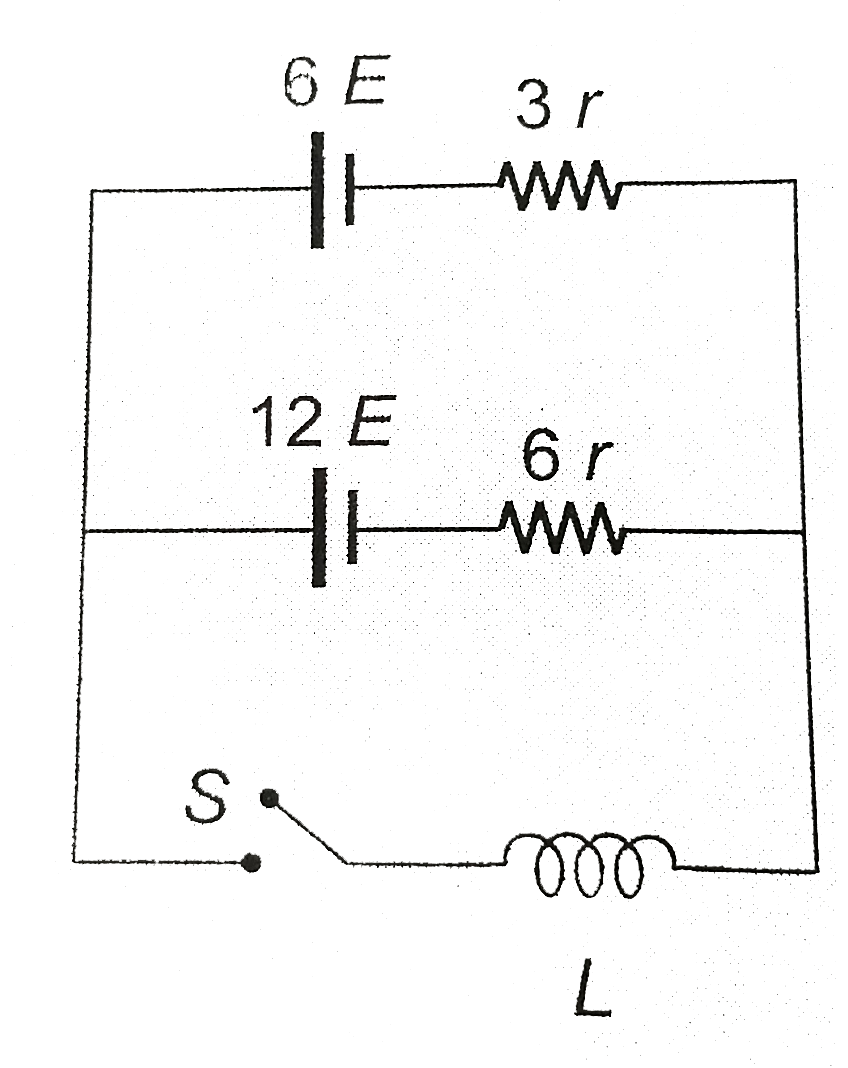
(b) 1 04:25View Solution
04:25View SolutionAn inductor of inductance L=400 mH and resistor of resistance `R_(1) = 2(Omega) and R_(2) = 2 (Omega)` are connected to a battery of emf E = 12 Vas shown in the figure. The internal resistance of the battery is negligible. The switch S is closed at time t =0. What is the potential drop across L as a function of time? After the steady state is reached, the switch is opened. What is the direction and the magnitude of current through `R_(1)` as a function of time?
 10:49View Solution
10:49View SolutionInitally switch `S_(1)` is closed, after a long time, `S_(1)` is opened and `S_(2)` is closed. Find the heat produced in coil after long time.
 07:06View Solution
07:06View SolutionConsider the circuit shown in .(a) find the current through the battery a long time after the switch S is closed. (b) Suppose the switc is again opened at t = 0. What is the time cosstant of the discharging circuit? (c ) Find t current through the inductor after one time constant.
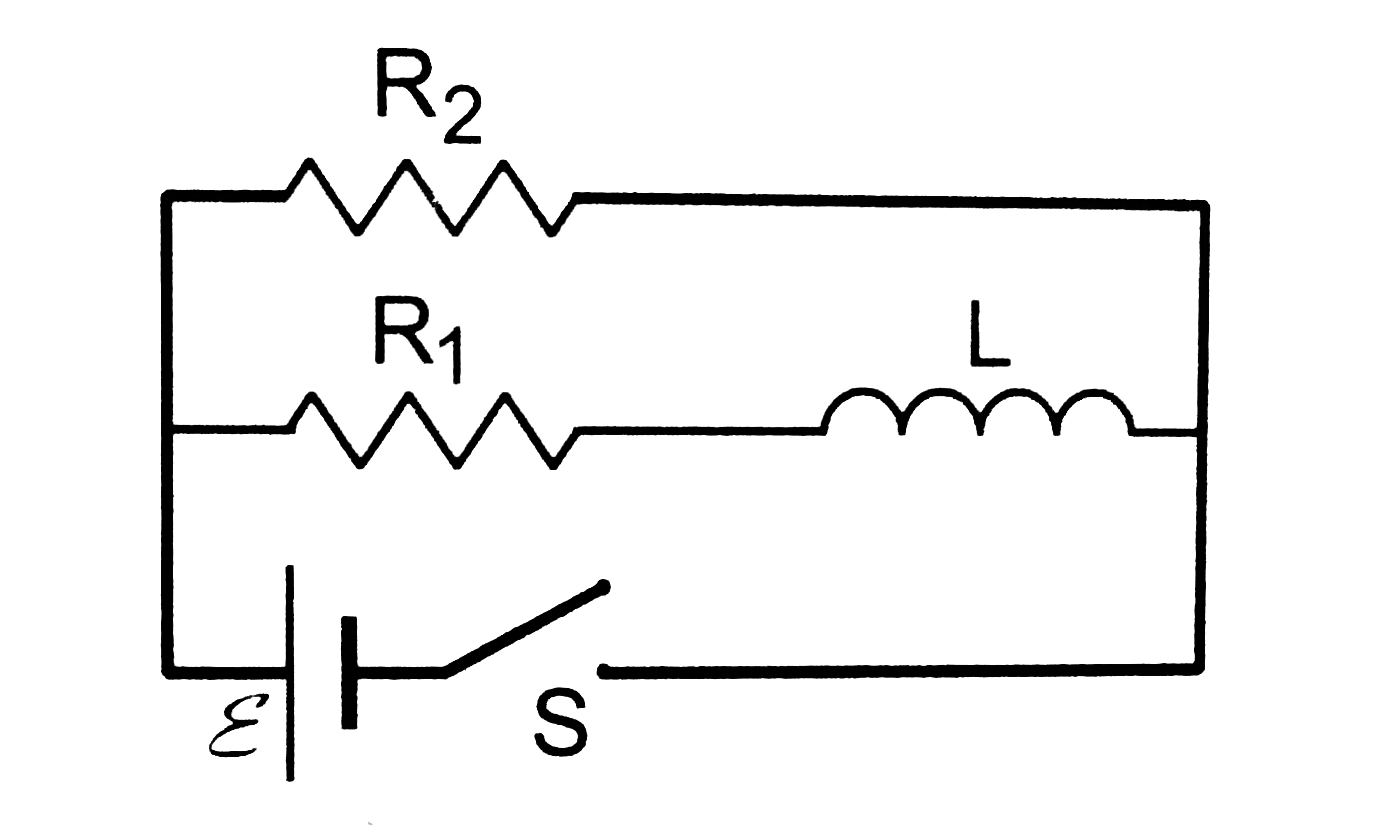 03:25View Solution
03:25View SolutionIn the circuit diagram shown, intially there is no energy in the inductor and the capacitor. The switch is closed at `t=0` . Find the current `I` as a function of time `t` .
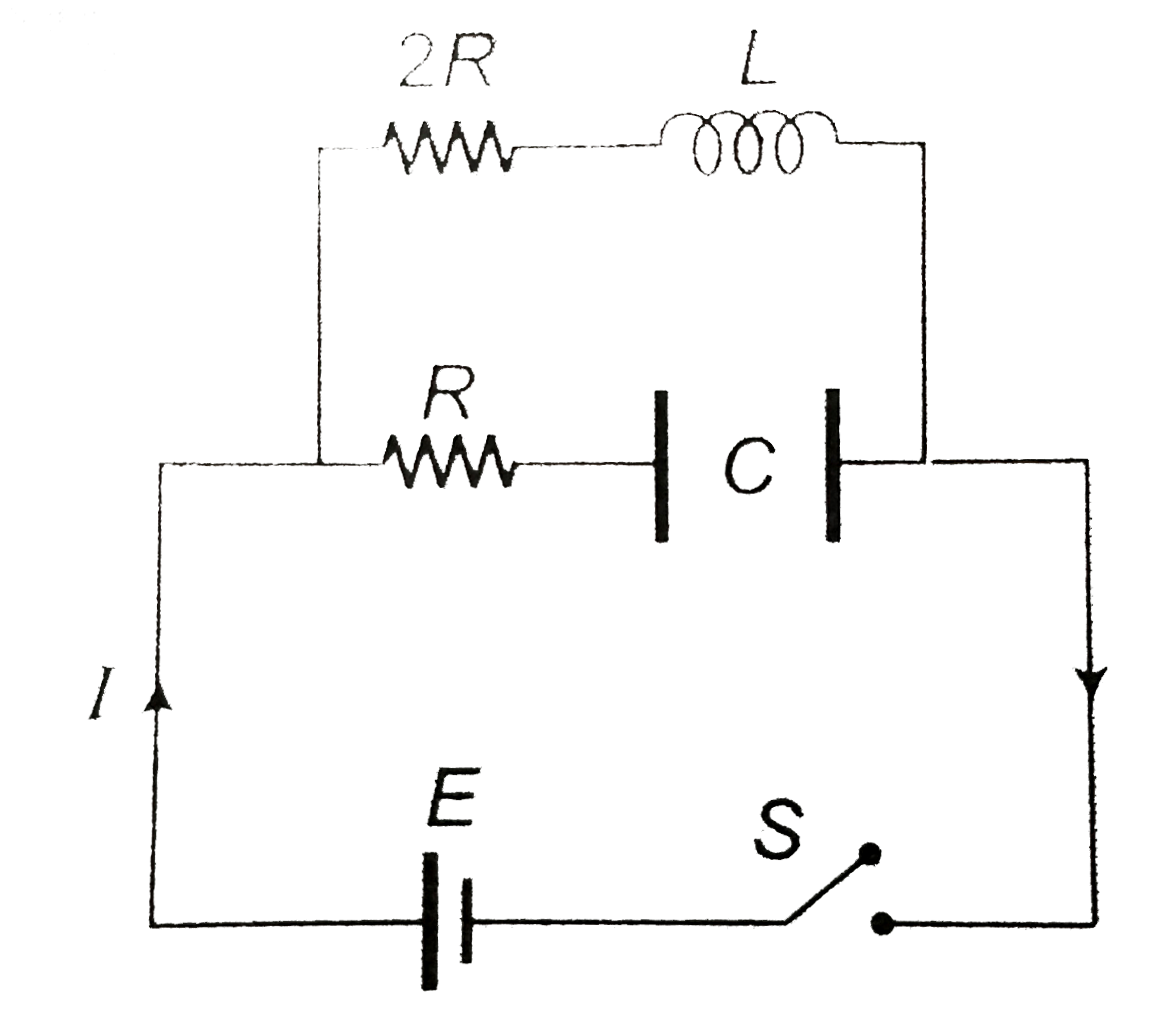 04:38View Solution
04:38View SolutionIn the figure both cells A and B are of equal emf. Find R for which potential difference across battery A will be zero, long time after the switch is closed. Internal resistance of batteries A and B `(r_1) and (r_2)` respectively`(r_(1)gtr_(2))`.
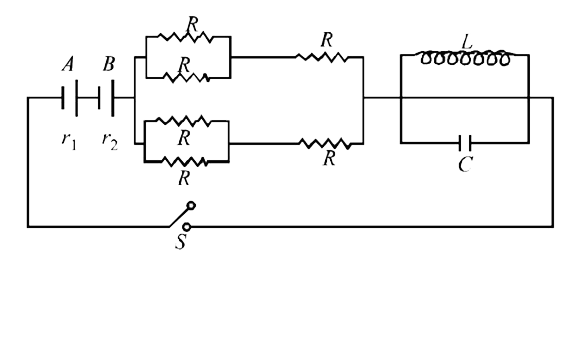 07:13View Solution
07:13View SolutionA capacitor of capacity `2muF` is changed to a potential different of `12V` . It is then connected across an inductor of inductance `0.6mH` What is the current in the circuit at a time when the potential difference across the capacitor is `6.0V` ?
05:21View Solution
EXAMPLE questions and complete solutions for chapter ELECTROMAGNETIC INDUCTION of CP SINGH PHYSICS (HINGLISH) of Class 12
